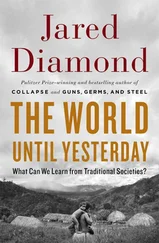Jared Diamond - Guns, Germs & Steel
Здесь есть возможность читать онлайн «Jared Diamond - Guns, Germs & Steel» весь текст электронной книги совершенно бесплатно (целиком полную версию без сокращений). В некоторых случаях можно слушать аудио, скачать через торрент в формате fb2 и присутствует краткое содержание. Жанр: 105. Описание произведения, (предисловие) а так же отзывы посетителей доступны на портале библиотеки ЛибКат.
- Название:Guns, Germs & Steel
- Автор:
- Жанр:
- Год:неизвестен
- ISBN:нет данных
- Рейтинг книги:5 / 5. Голосов: 1
-
Избранное:Добавить в избранное
- Отзывы:
-
Ваша оценка:
- 100
- 1
- 2
- 3
- 4
- 5
Guns, Germs & Steel: краткое содержание, описание и аннотация
Предлагаем к чтению аннотацию, описание, краткое содержание или предисловие (зависит от того, что написал сам автор книги «Guns, Germs & Steel»). Если вы не нашли необходимую информацию о книге — напишите в комментариях, мы постараемся отыскать её.
Guns, Germs & Steel — читать онлайн бесплатно полную книгу (весь текст) целиком
Ниже представлен текст книги, разбитый по страницам. Система сохранения места последней прочитанной страницы, позволяет с удобством читать онлайн бесплатно книгу «Guns, Germs & Steel», без необходимости каждый раз заново искать на чём Вы остановились. Поставьте закладку, и сможете в любой момент перейти на страницу, на которой закончили чтение.
Интервал:
Закладка:
3 9 2 ' GUNS, GERMS, AND STEEL
Pygmies, or because the people themselves disappeared.
The survival of modern Africa's four native language families (that is, the four other than the recently arrived Austronesian language of Madagascar) isn't due to the intrinsic superiority of those languages as vehicles for communication. Instead, it must be attributed to a historical accident: ancestral speakers of Nilo-Saharan, Niger-Congo, and Afroasiatic happened to be living at the right place and time to acquire domestic plants and animals, which let them multiply and either replace other peoples or impose their language. The few modern Khoisan speakers survived mainly because of their isolation in areas of southern Africa unsuitable for Bantu farming.
defore we trace Khoisan survival beyond the Bantu tide, let's see what archaeology tells us about Africa's other great prehistoric population movement—the Austronesian colonization of Madagascar. Archaeologists exploring Madagascar have now proved that Austronesians had arrived at least by a.d. 800, possibly as early as a.d. 300. There the Austronesians encountered (and proceeded to exterminate) a strange world of living animals as distinctive as if they had come from another planet, because those animals had evolved on Madagascar during its long isolation. They included giant elephant birds, primitive primates called lemurs as big as gorillas, and pygmy hippos. Archaeological excavations of the earliest human settlements on Madagascar yield remains of iron tools, livestock, and crops, so the colonists were not just a small canoeload of fishermen blown off course; they formed a full-fledged expedition. How did that prehistoric 4,000-mile expedition come about?
One hint is in an ancient book of sailors' directions, the Periplus of the Erythrean Sea, written by an anonymous merchant living in Egypt around a.d. 100. The merchant describes an already thriving sea trade connecting India and Egypt with the coast of East Africa. With the spread of Islam after a.d. 800, Indian Ocean trade becomes well documented archaeologi-cally by copious quantities of Mideastern (and occasionally even Chinese!) products such as pottery, glass, and porcelain in East African coastal settlements. The traders waited for favorable winds to let them cross the Indian Ocean directly between East Africa and India. When the Portuguese navigator Vasco da Gama became the first European to sail around the southern cape of Africa and reached the Kenya coast in 1498, he encountered
HOW AFRICA BECAME BLACK • 393
Swahili trading settlements and picked up a pilot who guided him on that direct route to India.
But there was an equally vigorous sea trade from India eastward, between India and Indonesia. Perhaps the Austronesian colonists of Madagascar reached India from Indonesia by that eastern trade route and then fell in with the westward trade route to East Africa, where they joined with Africans and discovered Madagascar. That union of Austronesians and East Africans lives on today in Madagascar's basically Austronesian language, which contains loan words from coastal Kenyan Bantu languages. But there are no corresponding Austronesian loan words in Kenyan languages, and other traces of Austronesians are very thin on the ground in East Africa: mainly just Africa's possible legacy of Indonesian musical instruments (xylophones and zithers) and, of course, the Austronesian crops that became so important in African agriculture. Hence one wonders whether Austronesians, instead of taking the easier route to Madagascar via India and East Africa, somehow (incredibly) sailed straight across the Indian Ocean, discovered Madagascar, and only later got plugged into East African trade routes. Thus, some mystery remains about Africa's most surprising fact of human geography.
What can archaeology tell us about the other great population movement in recent African prehistory—the Bantu expansion? We saw from the twin evidence of modern peoples and their languages that sub-Saharan Africa was not always a black continent, as we think of it today. Instead, this evidence suggested that Pygmies had once been widespread in the rain forest of Central Africa, while Khoisan peoples had been widespread in drier parts of subequatorial Africa. Can archaeology test those assumptions?
In the case of the Pygmies, the answer is "not yet," merely because archaeologists have yet to discover ancient human skeletons from the Central African forests. For the Khoisan, the answer is "yes." In Zambia, to the north of the modern Khoisan range, archaeologists have found skulls of people possibly resembling the modern Khoisan, as well as stone tools resembling those that Khoisan peoples were still making in southern Africa at the time Europeans arrived.
As for how the Bantu came to replace those northern Khoisan, archaeological and linguistic evidence suggest that the expansion of ancestral
394 " GUNS, GERMS,and steel
Bantu farmers from West Africa's inland savanna south into its wetter coastal forest may have begun as early as 3000 b.c. (Figure 19.4). Words still widespread in all Bantu languages show that, already then, the Bantu had cattle and wet-climate crops such as yams, but that they lacked metal and were still engaged in much fishing, hunting, and gathering. They even lost their cattle to disease borne by tsetse flies in the forest. As they spread into the Congo Basin's equatorial forest zone, cleared gardens, and increased in numbers, they began to engulf the Pygmy hunter-gatherers and compress them into the forest itself.
By soon after 1000 b.c. the Bantu had emerged from the eastern side of the forest into the more open country of East Africa's Rift Valley and Great Lakes. Here they encountered a melting pot of Afroasiatic and Nilo-Saharan farmers and herders growing millet and sorghum and raising livestock in drier areas, along with Khoisan hunter-gatherers. Thanks to their wet-climate crops inherited from their West African homeland, the Bantu were able to farm in wet areas of East Africa unsuitable for all those previous occupants. By the last centuries b.c. the advancing Bantu had reached the East African coast.
In East Africa the Bantu began to acquire millet and sorghum (along with the Nilo-Saharan names for those crops), and to reacquire cattle, from their Nilo-Saharan and Afroasiatic neighbors. They also acquired iron, which had just begun to be smelted in Africa's Sahel zone. The origins of ironworking in sub-Saharan Africa soon after 1000 b.c. are still unclear. That early date is suspiciously close to dates for the arrival of Near Eastern ironworking techniques in Carthage, on the North African coast. Hence historians often assume that knowledge of metallurgy reached sub-Saharan Africa from the north. On the other hand, copper smelting had been going on in the West African Sahara and Sahel since at least 2000 b.c. That could have been the precursor to an independent African discovery of iron metallurgy. Strengthening that hypothesis, the iron-smelting techniques of smiths in sub-Saharan Africa were so different from those of the Mediterranean as to suggest independent development: African smiths discovered how to produce high temperatures in their village furnaces and manufacture steel over 2,000 years before the Bessemer furnaces of 19th-century Europe and America.
With the addition of iron tools to their wet-climate crops, the Bantu had finally put together a military-industrial package that was unstoppable in the subequatorial Africa of the time. In East Africa they still had to
HOW AFRICA BECAME BLACK • 395
The Bantu expansion: 3000 bc to ad 500
Интервал:
Закладка:
Похожие книги на «Guns, Germs & Steel»
Представляем Вашему вниманию похожие книги на «Guns, Germs & Steel» списком для выбора. Мы отобрали схожую по названию и смыслу литературу в надежде предоставить читателям больше вариантов отыскать новые, интересные, ещё непрочитанные произведения.
Обсуждение, отзывы о книге «Guns, Germs & Steel» и просто собственные мнения читателей. Оставьте ваши комментарии, напишите, что Вы думаете о произведении, его смысле или главных героях. Укажите что конкретно понравилось, а что нет, и почему Вы так считаете.










